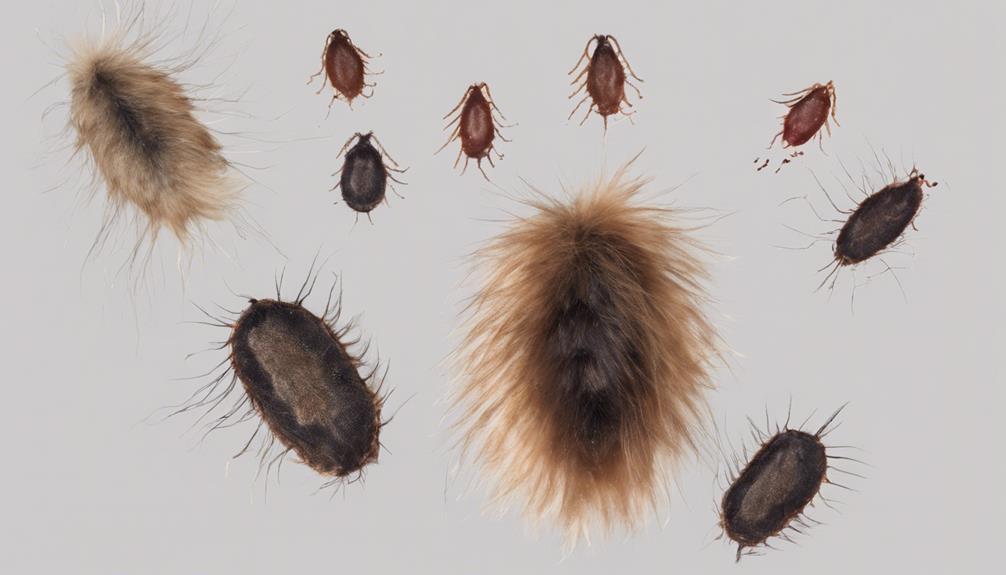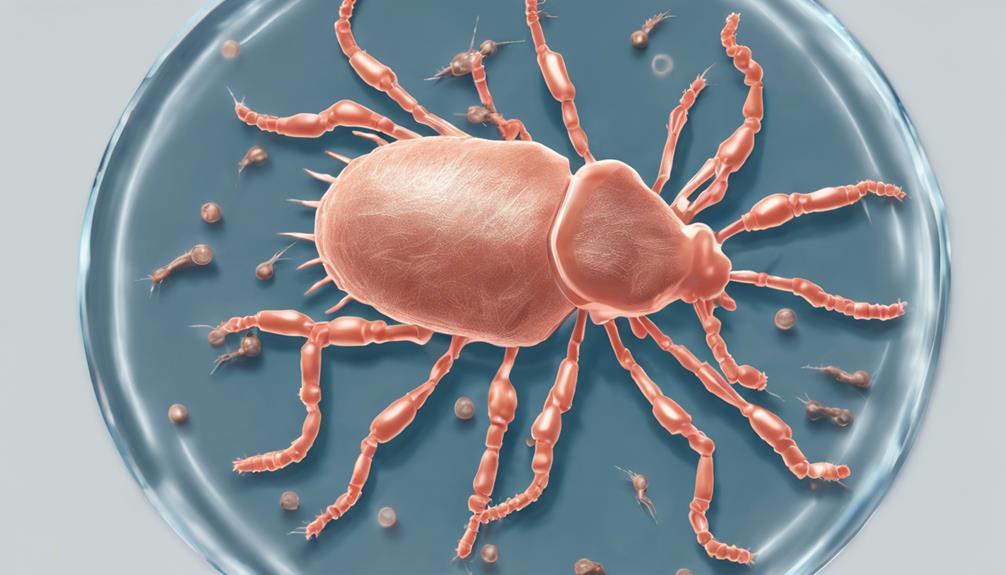Does Nexgard Kill Ticks Already on Dog
Nexgard effectively kills ticks already on your dog. It disrupts their nervous systems, stops feeding, and prevents secure attachment to your dog’s skin. It’s a fast and efficient method for tackling existing tick problems. If you want to discover more about how Nexgard works and tips for maximizing its effectiveness, stick around!
Key Takeaways
- Nexgard’s afoxolaner disrupts tick nervous systems, killing ticks already on the dog.
- Afoxolaner causes hyperexcitation, paralysis, and death in ticks, eliminating existing infestations.
- Starts working within hours of administration to quickly eliminate ticks on the dog.
- Nexgard targets ticks without harming dogs, ensuring safety during tick elimination.
- Administering Nexgard before tick attachment enhances its effectiveness in killing ticks on the dog.
How Nexgard Targets Tick Infestations
When targeting tick infestations, Nexgard actively eliminates ticks on dogs by disrupting their nervous system. This disruption is crucial in preventing the ticks from feeding on your furry friend, ultimately leading to their demise. By interfering with the ticks’ nervous system, Nexgard ensures that the ticks are unable to attach themselves securely to your dog’s skin and feed on their blood. This action not only helps in getting rid of existing ticks but also prevents new ticks from infesting your pet.
Nexgard’s targeted approach means that it specifically goes after ticks without harming your dog in the process. Once your dog ingests Nexgard, the active ingredient quickly gets to work, ensuring that ticks are effectively eliminated. This fast-acting formula provides relief to your pet from the discomfort caused by tick infestations. Remember to administer Nexgard as directed by your veterinarian to ensure that your dog remains protected against these pesky parasites.
Understanding Nexgards Mode of Action
To grasp how Nexgard works, consider its mode of action against ticks. Nexgard contains a powerful active ingredient called afoxolaner. This ingredient works by targeting the nervous system of ticks. When a tick attaches and starts feeding on your dog, afoxolaner is ingested into the tick’s body. Once inside the tick, afoxolaner interferes with specific receptors that are essential for the tick’s normal nerve function. By disrupting these receptors, afoxolaner causes hyperexcitation in the tick’s nervous system, leading to paralysis and ultimately death of the tick.
This mode of action is effective because it specifically targets ticks and not your dog. Since afoxolaner is only activated when a tick feeds on your dog, it helps ensure that the treatment is safe for your furry companion. By understanding how Nexgard’s active ingredient works against ticks, you can feel confident in its ability to combat tick infestations and protect your dog from these harmful parasites.
Nexgards Efficacy Against Existing Ticks
Nexgard effectively eliminates existing ticks on dogs by disrupting their nervous systems through the active ingredient afoxolaner. Once your dog ingests Nexgard, afoxolaner is absorbed into the bloodstream, quickly reaching the tick’s body when it attaches to your pet. This powerful ingredient interferes with the ticks’ nerve transmission, causing hyperexcitation, paralysis, and ultimately leading to their death. Within hours of administration, Nexgard starts to take effect, swiftly killing ticks that are already present on your furry friend.
It’s important to note that Nexgard is designed to work proactively to prevent tick infestations, but it also has the added benefit of rapidly eliminating any ticks that have already latched onto your dog. By administering Nexgard regularly as directed by your veterinarian, you can help ensure that your dog stays protected from ticks and the diseases they may carry.
Factors Impacting Nexgards Tick-Killing Ability
Factors such as the size and species of the tick, as well as the timing of Nexgard administration in relation to tick attachment, can influence its effectiveness in killing ticks on dogs. Larger ticks may require more time to be affected by Nexgard compared to smaller ones. Different tick species also vary in susceptibility to the active ingredients in Nexgard.
Administering Nexgard before ticks have had a chance to attach and feed on your dog can enhance its effectiveness. However, if ticks have already attached, Nexgard may take longer to kill them. It’s essential to follow the recommended Nexgard dosing schedule for optimal results.
Understanding these factors can help you make informed decisions about how to best protect your dog from ticks and maximize Nexgard’s tick-killing ability. Remember to consult your veterinarian for advice tailored to your dog’s specific needs and circumstances.
Tips for Maximizing Nexgards Tick Control
Maximize your dog’s protection against ticks by following these practical tips to enhance Nexgard’s tick control effectiveness. Firstly, ensure you administer Nexgard as directed by your veterinarian. Consistency is key in maintaining its efficacy. Remember to give Nexgard to your dog on a regular schedule without skipping doses.
Additionally, it’s crucial to monitor your dog for any signs of tick infestation, even with Nexgard. Regularly check your furry friend for ticks, especially after outdoor adventures. Promptly remove any ticks you find to prevent potential diseases.
Furthermore, consider combining Nexgard with other preventive measures for comprehensive tick control. Using Nexgard alongside tick collars or environmental treatments can provide added protection against these pesky parasites.
Lastly, maintaining a clean living environment for your dog can also contribute to Nexgard’s effectiveness. Regularly clean and groom your pet, wash their bedding, and vacuum your home frequently to reduce the risk of tick infestation.
Frequently Asked Questions
Can Nexgard Be Used on Puppies or Only Adult Dogs?
You can use Nexgard on puppies as well as adult dogs. It’s important to follow the recommended dosage based on your pet’s weight. Nexgard is effective in protecting dogs from fleas and ticks, keeping them healthy.
Are There Any Known Side Effects or Risks Associated With Using Nexgard for Tick Control?
When using Nexgard for tick control, it’s essential to be aware of potential side effects or risks. While effective, some dogs may experience mild side effects like vomiting or diarrhea. Consult your vet for guidance.
How Often Should Nexgard Be Administered to Effectively Kill Ticks on Dogs?
To effectively kill ticks on your dog, administer Nexgard as directed by your vet. Consistent dosing is key for optimal protection. Trust the recommended schedule to keep those pesky ticks at bay and your pup healthy.
Is Nexgard Safe to Use in Combination With Other Tick Prevention Methods or Medications?
You can safely use Nexgard in combination with other tick prevention methods or medications. Consult your vet for the best approach. It’s important to ensure compatibility and maximize protection against ticks.
Does Nexgard Have Any Impact on Preventing Ticks From Re-Infesting the Dog After Initial Treatment?
When it comes to preventing ticks from re-infesting your dog after initial treatment, Nexgard can be effective. It helps protect your furry friend from potential tick infestations, keeping them safe and healthy.
Conclusion
In conclusion, Nexgard is designed to kill ticks already on your dog by disrupting their nervous system and ultimately leading to their death.
While Nexgard is effective against existing tick infestations, it’s important to follow proper dosage and administration guidelines to maximize its tick-killing ability.
By using Nexgard as directed and taking preventive measures, you can help protect your furry friend from harmful tick-borne diseases.








